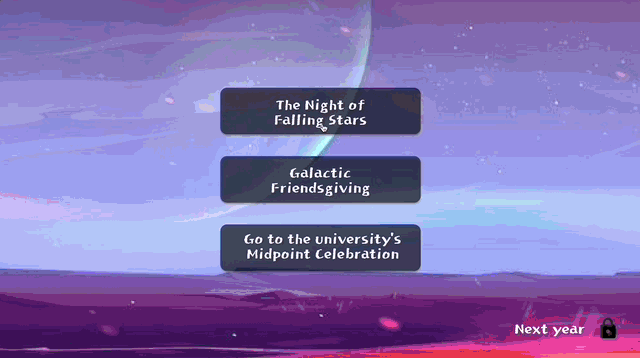INITIAL PROBLEM
SOLUTION
Summary + Context
Journeys at Glipthor is a choose-your-adventure game based in an alien world, where players play as one of three alien college students and embark on extraterrestrial experiences. Its aim is to effectively raise awareness of the consequences of irresponsible drinking to college students and promote responsible drinking habits in an enjoyable and immersive experience.
ROLE
UX Designer, Project Manager, Storywriter
TEAM
3 UX Designers, 1 Graphic Designer
TIMELINE
November - Mid-December (6 weeks)
RESULTS
42% indicated genuine interest in game’s message and purpose
100% of players rated game as “Enjoyable” or “Very Enjoyable”
College students’ understanding, awareness, and practice of responsible drinking are notably limited.
Alcohol is commonly consumed by college students, and many of them, if not responsible with their drinking habits, can become alcoholics while in school or past graduation. How can we encourage responsible alcohol consumption among college students and prevent alcohol misuse without relying solely on traditional interventions for established alcohol use disorders?
LITERATURE REVIEW
College alcohol consumption is closely tied to emotional influences, both internal and external.
I delved into some initial research into the main reasons regarding why college students tend to drink. One research paper highlighted that, from a survey taken by college students, social camaraderie was rated the biggest reason for drinking, followed closely by mood enhancement and tension reduction. However, all of these reasons have one thing in common: emotions (Labrie, 2007).
COMPETITIVE ANALYSIS
Current solutions lack a personal emotional connection between the product and user
After analyzing current solutions for preventing/intervening with alcohol misuse, I found reasons as to why they weren’t effective, especially with college students:
USER INTERVIEWS
Our white paper research revealed a strong link between college alcohol consumption and emotional influences. To delve deeper, we interviewed CMU college students who consume alcohol to understand motivations, internal and external emotional factors, and their perspectives on existing alcohol misuse prevention and interventions.
RESEARCH QUESTIONS:
How do your emotional state and emotional triggers impact your alcohol consumption?
How does stress impact your alcohol consumption?
How do peer pressure and social influence impact your alcohol consumption?
How do your parental/family pressures impact your alcohol consumption?
Have you used any alcohol misuse resources/interventions before? Why or why not? Were they helpful?
TAKEAWAYS/MAIN INSIGHTS
Emotions are everything when it comes to the topic of alcohol consumption
Putting together all the research from competitive analysis and user interviews, we narrowed down the important themes to focus on for our product using affinity mapping:
DESIGN
Ideation setbacks + a new approach
We initially planned a mobile app integrating features from our main insights but faced challenges with user motivation and addressing the topic indirectly. To overcome this, we pivoted to the idea of an alien college life game, offering creative freedom for emotional engagement and an enjoyable experience.
JOURNEY MAP
Opportunity to solidify enjoyability and empathy by delaying the consequences of alcoholism
Crafting the player’s journey map revealed insights for an ideal experience and overall structure/flow of the game, leading to the discovery of an opportunity to encompass all three of my main insights: incorporating events unrelated to alcohol and delaying the character's encounter with the negative consequences of alcoholism until the end of the game.
STORYBOARDING
I sketched some storyboards to visualize the potential scenes and to determine the direction of the game narrative. Doing so also helped us to figure out the order of events that happen in the game.
USER PERSONA
ITERATION + IMPROVEMENTS
After three rounds of testing playthroughs with college students, as well as one with our professor, we made changes according to their feedback and suggestions:
FINAL GAME
FINAL TESTING
42% of players embraced the game's main purpose and message
We assessed the final game’s effectiveness by analyzing user choices between "End Game" and "Link to External Resources” to see if the message was persuasively conveyed well and were persuaded by it. We also gauged enjoyment through a survey.
REFLECTION
🎮 Learning about game design
This project aimed to address irresponsible drinking among college students, evolving into a game that required game design skills, a domain unfamiliar to the team. Through this process, I gained valuable insights into game design techniques and effective storytelling for an engaging choose-your-adventure game.
💭 Storyboarding is especially vital to game design
Storyboarding is incredibly important for focusing on a user’s perspectives and needs. In game design, it’s especially crucial, especially for narrative games such as this one to ensure immersion and enjoyment by developing the plot, adding richness, and addressing storyline inconsistencies.
Emotional connection and presentation significantly impacts the player's experience. Simple changes in wording, incorporation of detailed character and narrative sequences, and an anticipated lead-up to a pivotal moment profoundly altered player perception and ultimately enhanced the game’s persuasiveness.
The point of a game is to be enjoyable. Initially, we overlooked the importance of a lighthearted, enjoyable narrative in the game, focusing too much on the alcohol misuse topic. This imbalance led to dissatisfaction in early testing rounds. A more balanced focus on enjoyment and message effectiveness is crucial for a successful game.
📖 Nuanced storytelling can be a form of persuasion
🤩 Stay focused on the essence of a game.
REVISED PROBLEM STATEMENT
How can we develop an engaging product that establishes an empathic connection with the user, gently addressing the issue of irresponsible drinking among college students?
After synthesizing qualitative insights from our research, we revised our problem statement and narrowed our product scope to better meet the product’s goals tailored for college students.















